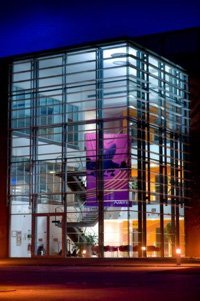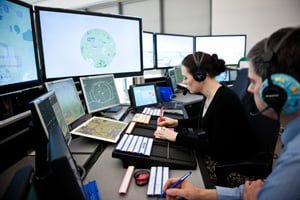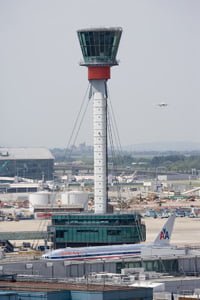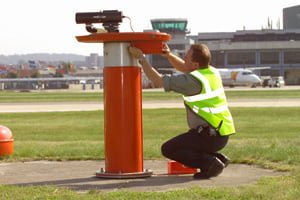
Over 3,000 extra flight slots were needed for the visitors and athletes for the London Olympic Games. Making sure all flights have a safe landing and take-off is part of the responsibilities of NATS.
NATS is a global air navigation provider. The organisation was originally established in 1962 as a government body but in 2001 became a Public/Private Partnership (PPP). The PPP model of ownership meant that private funding could be invested into NATS services and infrastructure. Over £123 million has been invested since the PPP was set up.
NATS manages the world’s busiest section of airspace as well as the busiest single and dual runway airports in Europe and the Middle East. Its systems and people manage over 6,000 flights a day through UK airspace – over 2 million a year – safely and efficiently. NATS-managed flights experienced delays of just 7.3 seconds per flight in 2011, around 1/10 of the European average. The majority of delays to flights in and out of the UK are caused by factors outside NATS’ control.
Rate of growth

As well as managing 15 of the UK’s busiest airports, NATS projects currently include air traffic controller training and redesigning airspace in Hong Kong; providing start-up training for ATC and safety management in Slovakia; as well as providing and integrating all ATC equipment for the new control tower at Manchester airport.
NATS recognises that its people are a cornerstone of its strategy and essential to its future development. NATS offers a broad mix of challenging and exciting job roles which are open to men and women equally. These include the essential ATC role, scientists, marketing, business development, IT, finance, HR, safety, quality and business processing. With its expansion, NATS is moving from a national to international employer. This means future recruits will have a world of job opportunities to choose from.
This case study explores the strategies NATS is employing to achieve its vision of being a global provider of air traffic solutions.

The aviation sector as a whole is experiencing significant change with air traffic management services now being a global market. NATS needs to be able to respond to economic pressures and meet efficiency and environmental targets. It also has to be able to meet the challenge of increasing numbers of competitors bidding for global contracts.
NATS’ vision
NATS’ vision is: ‘to be acknowledged as a global leader in innovative air traffic solutions and airport performance’. In order to achieve its vision, NATS has established several key aims:
- Continuous growth for the business, both organic and inorganic with a view to achieving and sustaining turnover of over £1bn by 2015.
- Reducing safety risks across the business – NATS handled 2.1 million flights in 2011. For the fourth year running, there were no incidents where the distance between aircraft under NATS air traffic control was compromised. In an industry where safety is of the greatest importance, NATS has also developed safety innovations such as a GPS-based device to help private pilots avoid controlled airspace, as well as a system to track helicopter flights between oil platforms in the North Sea.
- Engaging with and focusing on its customers’ needs – this includes implementing technical developments that will deliver fuel savings for airlines, improve efficiency and ensure continued punctuality and reduced operating costs for airports.
- Increasing efficiency and effectiveness of internal operations – for example, NATS efficiency in purchasing has been recognised with the award of the Gold certificate from CIPS (the Chartered Institute of Purchasing and Supply). This has resulted in cost savings and established best practice for all parts of the business.
- Reducing carbon emissions – for example NATS made over 100 operational and procedural changes in air traffic flows. These have saved an estimated 115,000 tonnes of CO2 emissions since 2009 – a fuel saving worth £22 million.
Objectives set out the outcomes the business needs in order to achieve its aims and may relate to functions or the whole business.
SMART objectives
The use of SMART objectives helps a business to ensure that its progress towards achieving its objectives can be measured.
Specific – so that everyone knows exactly what is to be achieved
Measurable – sets out the level to be achieved
Agreed – relevant staff are involved in setting the objectives and are committed to keeping them
Relevant – to the organisation’s overall purpose
Time-framed – to ensure that it will fit within the organisation’s overall plans
Examples of SMART objectives set by NATS include:
To reduce the level of safety risk across the business by 40% over a period of four years.
To reduce CO2 emissions related to air traffic management by an average of 10% per flight by 2020, from a 2006 baseline. The interim target is to achieve an average of 4% per flight reduction by 2015.

A strategy is the plan by which the aims and objectives will be put into action. NATS’ strategies centre around three key areas:
- Innovation – developing new and creative products and services to retain market position and grow the business
- Partnerships – creating alliances to strengthen its position and open up new markets
- People – enhancing the organisation’s skills and competencies so it has the resources to meet challenges.
Innovation

Partnerships
Working with and through partners to deliver new solutions is helping NATS to expand its reach into global markets. For example, NATS has established a relationship in Spain with Ferroser, a private investor in transportation infrastructures. The joint venture (known as FerroNATS) enabled NATS to win a bid for running airport tower operations in Spain.
People

NATS training and development schemes enable the organisation to continue to develop the competencies which give it competitive edge and drive its vision forwards. People may join NATS at all levels – from school or college as air traffic controllers or engineering technicians or as graduates on its science or engineering graduate schemes.
In addition, NATS also offers industrial placement schemes, where students can include a year working with NATS as part of their degree courses to develop skills and learn about the industry. NATS employees have opportunities to develop their abilities, for example, through secondments.
Evaluation
Effective strategies require careful assessment of the progress made during the timescale of the strategies being set. The monitoring of the changes is summarised in the final section of the case study.

3Di – a world ‘first’
For example, NATS delivered a world ‘first’ by developing an entirely new way of measuring the environmental performance of the airspace network above the UK. The flight efficiency metric, known as 3Di, will help air traffic control to route flight paths as close to the environmental optimum as possible. NATS’ regulator, the Civil Aviation Authority, estimates that it will deliver 600,000 tonnes of CO2 savings over the next three years, worth up to £120 million.
‘Perfect flight’ test

Management of data
Timely and accurate management of data and information is vital for airports, airlines and air traffic control services. NATS is implementing a virtual and secure ‘cloud’-based infrastructure for all its desktop IT services. This will reduce IT costs by £9 million over four years and allow better use of information for NATS 6,000 staff, as well as improved collaboration between NATS and its business partners.
Single European Sky initiative

Developing people
In line with its HR strategy, NATS opened a new training centre in 2011. This specialised centre of excellence for training engineers and air traffic controllers has delivered cost savings and improved the training environment through the use of innovative simulation technology. NATS recognises that its people are a valuable asset and has therefore also introduced a new performance management and career development programme to enable it to manage and reward its talented people appropriately.

At a time of global economic recession, NATS has delivered ways to help its customers add value, reduce emissions and save fuel. In 2011, by implementing operational and procedural changes from the air traffic control centres, NATS enabled fuel savings of over 19,000 tonnes. This was worth almost £13 million and saved 60,000 tonnes of CO2 emissions.
